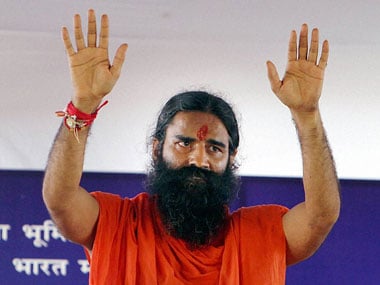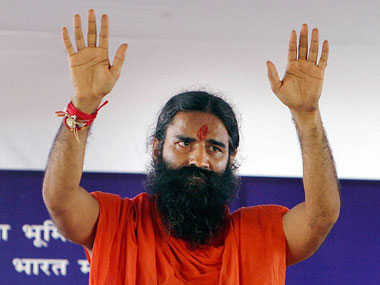Editor’s note: From selling chawanprash on a bicycle and teaching yoga to small groups of people in the late 1990s, Baba Ramdev now heads a multi-billion-dollar consumer goods empire. In ‘Godman to Tycoon: The Untold Story of Baba Ramdev’, author Priyanka Pathak-Narain traces his story. The following is an extract from her book. At the turn of the millennium, yoga had a moment of runaway success. Suddenly, it was cool again to be a yogi. After the heady love affair that the West had with India and its godmen in the 1970s, things had cooled off considerably. This was, if you will, a second fling. [caption id=“attachment_2704266” align=“alignleft” width=“380”]
 Yoga guru Ramdev. PTI/File Photo[/caption] Celebrities in the west embraced its practice and yoga captured the world’s imagination. Naturally, the growing American obsession renewed Indian interest in yoga. And while well-heeled Indians acquired yoga instructors, the rest of India had neither access to good yoga teachers nor the money to pay for them. The travelling yoga teachers Ramdev and Karamveer did not miss the surging crowds clamouring to attend their yoga camps. Seeing the increasing curiosity about yoga, especially among the elites, in 2000 Ramdev and Karamveer organised a free yoga camp for local authorities in Haridwar. The Haridwar superintendent of police and the district magistrate attended this very successful week-long session at Bhalla College. From this point on, befriending government officials and politicians, both in and out of power, would become a trademark growth strategy of Baba Ramdev’s. All the ingredients were in place: a global momentum was building behind yoga, religious television channels were on the rise and there was a huge dearth of good yoga teachers. The stage was set for the right yoga guru to take his place on the stage. Madhav Kant Mishra was paying attention. ‘I knew that just having swamis talking and lecturing on television was not going to be enough . . . Anything to do with yoga and health would do well,’ he remembers. So he went looking for the right yoga guru for Aastha. ‘I had three choices,’ he recalls. Karamveer, Ramdev and a third local yoga teacher based near Haridwar. ‘But only one of them was a saffron-robed guru,’ he says, smiling. ‘The optics of that were promising because I knew our audience would prefer to learn from a sanyasi.’ Karamveer, Ramdev’s mentor, had lost out to his protégé. Mishra’s hunt for an orange-robed yoga teacher brought him to Kripalu Bagh Ashram. ‘When I saw Ramdev do that nauli kriya, churning his stomach . . . I knew he would be a big hit,’ says Mishra. He made a recording of Ramdev teaching yoga and sent it to Aastha’s promoters in Mumbai for the green light to put Ramdev on air. Unimpressed with what they saw of Ramdev on that tape, Aastha promoter Kirit Mehta and CEO Ajit Gupta refused to air it. They simply said, ‘What boss? He moves his stomach around like that . . . it won’t work.’ It is not clear how Ramdev handled their rejection, but the idea of teaching yoga on television had fired his imagination. Within a few short weeks of discovering how the television business worked for swamis like him, he went to the rival Sanskar channel and secured himself 20 minutes of airtime at 6.45 am by paying for it.
Yoga guru Ramdev. PTI/File Photo[/caption] Celebrities in the west embraced its practice and yoga captured the world’s imagination. Naturally, the growing American obsession renewed Indian interest in yoga. And while well-heeled Indians acquired yoga instructors, the rest of India had neither access to good yoga teachers nor the money to pay for them. The travelling yoga teachers Ramdev and Karamveer did not miss the surging crowds clamouring to attend their yoga camps. Seeing the increasing curiosity about yoga, especially among the elites, in 2000 Ramdev and Karamveer organised a free yoga camp for local authorities in Haridwar. The Haridwar superintendent of police and the district magistrate attended this very successful week-long session at Bhalla College. From this point on, befriending government officials and politicians, both in and out of power, would become a trademark growth strategy of Baba Ramdev’s. All the ingredients were in place: a global momentum was building behind yoga, religious television channels were on the rise and there was a huge dearth of good yoga teachers. The stage was set for the right yoga guru to take his place on the stage. Madhav Kant Mishra was paying attention. ‘I knew that just having swamis talking and lecturing on television was not going to be enough . . . Anything to do with yoga and health would do well,’ he remembers. So he went looking for the right yoga guru for Aastha. ‘I had three choices,’ he recalls. Karamveer, Ramdev and a third local yoga teacher based near Haridwar. ‘But only one of them was a saffron-robed guru,’ he says, smiling. ‘The optics of that were promising because I knew our audience would prefer to learn from a sanyasi.’ Karamveer, Ramdev’s mentor, had lost out to his protégé. Mishra’s hunt for an orange-robed yoga teacher brought him to Kripalu Bagh Ashram. ‘When I saw Ramdev do that nauli kriya, churning his stomach . . . I knew he would be a big hit,’ says Mishra. He made a recording of Ramdev teaching yoga and sent it to Aastha’s promoters in Mumbai for the green light to put Ramdev on air. Unimpressed with what they saw of Ramdev on that tape, Aastha promoter Kirit Mehta and CEO Ajit Gupta refused to air it. They simply said, ‘What boss? He moves his stomach around like that . . . it won’t work.’ It is not clear how Ramdev handled their rejection, but the idea of teaching yoga on television had fired his imagination. Within a few short weeks of discovering how the television business worked for swamis like him, he went to the rival Sanskar channel and secured himself 20 minutes of airtime at 6.45 am by paying for it.
How Baba Ramdev became the guru of yoga programming on Indian TV
Priyanka Pathak Narain
• July 31, 2017, 16:50:35 IST
Ramdev’s trademark nauli kriya, an entrancing rippling of the stomach, had put Sanskar channel in the lead with 6.9 million viewers
Advertisement
)
Religious television channels had an unusual business model at that time. Unlike normal television networks that have to rely on advertisers, religious channels had access to a never-before-tapped revenue stream: the godmen themselves. Flush with funds from donations, these gurus saw in Aastha an opportunity not only to rally their bases, but also to recruit new converts. According to Mishra, within a year of its launch, the idealism that had spurred Aastha had faded. Religious gurus had quickly understood that TV was the most powerful way to reach people — inside their homes. ‘A situation evolved where religious gurus believed that if they wanted to survive in the religious marketplace, they had to be on Aastha. I will not take names, but religious gurus used to come to us and discuss their rivals — “Oh, you are running this guy? How much is he paying you? I will pay more.”’ Aastha’s and Sanskar’s airtime was being auctioned, offered to the highest bidder. This business model made it simple for Ramdev to shop for airtime with Sanskar channel, where a 20-minute slot cost Rs 1,50,000. Kabra, a key promoter of Sanskar, remembers his first meeting with Ramdev in Delhi with his manager, Gopal Maheshwari. Ramdev told them he could not pay the entire amount right away but he assured them that he would generate enough viewership to be able to pay them back. Where Mehta had refused to venture, Kabra decided to plunge in and take a chance on Ramdev. ‘There was something compelling about Ramdev_ji_ from the very beginning,’ he says. The first of Ramdev’s yoga shivirs, or camps, to be telecast on Sanskar was conducted in Haridwar. Knowing how much was riding on it, Ramdev must have been nervous, but his performance was sensational and his chemistry with the audience undeniable. He was the saffron-clad Pied Piper who could make his stomach churn and ripple, wrap his legs around his neck and dazzle viewers with dreams of eternal youth and instant good health. His audience was enchanted, and followed him into a dream land where cancer, homosexuality and HIV could be ‘cured’ by yoga, grey hair turned black, and the divine experienced. During that first shivir itself, he appealed to people for donations and was not disappointed. Two people in the live audience gave him cheques for Rs 5 lakh each, several times the amount he owed Sanskar for that time slot. When Ramdev’s slot helped drive up Sanskar’s TRP ratings, the folks at Aastha wondered: Had they made a mistake by passing him up? By July 2003 Television Audience Measurement Media Research reported that Sanskar had 6.9 million viewers. Aastha trailed behind at second position with 5.7 million viewers. Ramdev’s trademark nauli kriya, an entrancing rippling of the stomach, had clearly worked. The viewers were hooked. Excerpted with permission of Juggernaut Books from
Godman to Tycoon: The Untold Story of Baba Ramdev
by Priyanka Pathak-Narain, available in bookstores and on
www.juggernaut.in
End of Article